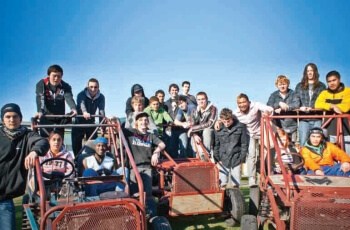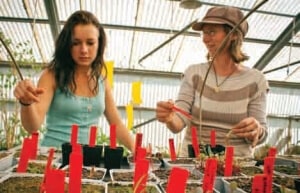I’ve been doing some reading while travelling recently – and annoying the heck out of the unfortunate people randomly seated next to me by Air New Zealand. Affirmative exclamations, air punches, and seat wriggling have been the order of the day on those plane trips. And as my family will tell you, I’m better known for being overly controlled than effusive.
But I can’t help it. I’ve been in the education profession wearing some hat or other for 25 years and for the first time I’m starting to see how we can actually achieve some national momentum around that old cliché – that the purpose of education is to change the world.
My new zeal is inspired by reports from three totally different organisations: The Forgotten Half by UK think tank Demos; Pathways to Prosperity by the Harvard Graduate School of Education in the USA; and More Ladders, Fewer Snakes by our own privately funded economic think tank, the New Zealand Institute.
All three reports focus on the potential to dramatically transform our struggling economies and societies by refocusing our education system on the ‘forgotten half’ of young people who are not heading for university education and who are not well-served by current education systems across the world.
The result of that service gap is evident in a number of areas that affect us all. The New Zealand Institute report lays out the disturbing statistics concisely and clearly and it’s well worth the read. In a nutshell, although our top 15-year-olds hold their own with the rest of the OECD in mathematics, science and reading, our ‘long tail’ of underachievers leads to dismal statistics across a range of other indicators – youth unemployment, health issues, teenage pregnancies, suicide, and adult literacy and numeracy difficulties.
But the key issue that emerges – and it’s where we can really make a difference that will transform all the stats – is that too few students are remaining ‘engaged’, or actively learning, at school.
New Zealand can’t hang on to its 16-18 year-olds in the school system, and a frightening number just drop out of sight. Those of us who have tried to coax our children to stay at school as long as possible, in spite of the fact they are obviously not enjoying it and not achieving, will know the angst and worry behind this issue. The reports I’ve been reading put this down to one main problem – too many young people can’t see a clear, transparent connection between their programme of study and tangible opportunities in the labour market.
I’ve tested this theory at home with my long-suffering husband who’s a mathematics teacher at a local secondary school. The discussion goes something like this:
Me: “What have you been teaching today?”
Him: “Had a great lesson with my Year 12s on algebra – went really well.”
Me (innocently): “That’s good! Do you know what jobs will use algebra the way you’re teaching it?”
Him (ominous silence): “What do you mean?”
Me (gathering steam): “So how do you know what you’re teaching is relevant to the workplace? I mean, without wanting to be critical, you’ve been a teacher all your life – so how do you know whether what you’re teaching is relevant to any workplace at all?”
Him: (now thoroughly peeved): “Well that’s not my job! I’m working my backside off trying to get my kids through NCEA Level 1, 2, and then 3 – when have I got time to undertake study tours of local industry?”
The rest I’ll leave to your imagination – divorce is often imminent!
But in that last comment lies the rub for New Zealand students currently, and I take my full share of responsibility for this … hindsight is a wonderful thing.
Making school relevant
As a secondary school principal I contributed to a system that focused almost exclusively on preparing our students to gain university entrance via intensive NCEA assessment in a relatively limited range of academic subjects. Yet in fact, the most recent figures I’ve seen indicate only 29% of New Zealand students go on to university. Even if it were 50% as it is in the UK, it’s the forgotten half that are now earning some well-deserved attention, and there’s some exciting stuff going on in this space.
At a recent symposium run by New Zealand’s ‘guru’ of secondary/tertiary transitions, Dr Stuart Middleton, Hawke’s Bay’s pilot initiatives to re-engage young people at risk of dropping out of school gained considerable attention. The results of these initiatives have surprised and delighted everyone involved.
For example, Wairoa College – partnering with EIT, the Agriculture ITO and some very supportive local farmers – set up an agricultural academy in 2009 to re-engage in education Year 12 students who were at risk of “dropping out” of school. Their programme consisted of two days of tertiary study, two days out on local farms gaining work experience, and one day in ‘mainstream’ school studies.
At the end of that first year’s pilot (and the results have been consistent ever since) 21 of the participating 24 students remained in the programme (and therefore at school) and the vast majority gained NCEA Level 1 or 2 along with a National Certificate in Agriculture Level 2. Sixteen students returned to school for Year 13.
Subsequent pilots with Hastings Girls’ High School and Tamatea High School, utilising similar models and based on Hospitality and Trades respectively, have yielded the same very exciting results. And remember these are young people formerly “at risk” of dropping out of the school system.
To see these students proudly serving their culinary creations to their teachers and whanau at Scholars’ restaurant; or having a ball racing around Manfield on the mini-motorbikes they had constructed; or welcoming the local crèche kids into the playhouses they had built for them as part of their carpentry programme – this was learning that had significant educational, social and vocational benefits that we had probably initially underestimated.
And it was learning with a clear purpose and a connection to the future world of work.
I’d like to be very clear here. Schools do a great job with more than half of the country’s students. My husband does a wonderful job as a mathematics teacher for those same students. Many schools and teachers are already embarking on alternative programmes for ‘the forgotten half’, but these programmes are currently on the fringes, rather than central to, our education system.
Regional partnerships such as the ones I have described here, made up of visionary school principals, EIT, local and central government leaders, and industry leaders and employers have the potential to be scaled up in order to create opportunities for the forgotten half of Hawke’s Bay’s young people to re-engage in education, training, work, and society.
Let’s join the New Zealand Institute in urging our government to do that. Because these are precisely the young people who desperately want and need to be connected and making a valuable contribution to our region. Let’s give them the skills, the guidance and above all the status of being in a system that is valued every bit as much as university education. We need all our young people engaged and active, not just half.



Back in 1995, when I was in 7th form at Tamatea High School (and Claire was Assistant Principal there) I made an important decision: I was not going to university. Heresy at the time, I know, as the whole process of high school even back then was to prepare you for entry to university. Pretty well everyone else in my year went on to tertiary things, but I didn’t know what I would do at uni’ and couldn’t stand the thought of spending three years and $30,000+ worth of student loan to find I still didn’t know what I wanted to do and be $30g in debt. The current system seems little different, (except no-one “passes” or “fails” any more, it would appear), yet the message is still the same “Off to uni you go!”
As it transpired, I ended up failing Bursary by two marks (if X=5 and Y=9, then who gives a damn?!) and would later go on to do a Diploma in Marketing at EIT (after around 50 failed marketing job applications I gave up waiting to be head-hunted) but that’s another story.
The likes of EIT have become an important part of “alternative” (read “practical”) learning for Hawke’s Bay students of all ages, but we can’t let ourselves (EIT, it’s students, Hawke’s Bay and its employers) be sold short.
Hospitality training courses like those offered to the secondary school students in the article are a great encouragement for the pupils to stay in study and set goals, but they ‘cater’ to the lower-paying end of the job market, which does not help our region’s already low ranking in the economy stakes.
Similarly, there needs to be the higher-paying jobs available in Hawke’s Bay for those who do their bachelors’ degrees, technical and other higher-end vocations at EIT, for the region to truly benefit from the income and education the institution provides. Our region haemorrhages young people as it is (only for the gap to be filled by those dreaded baby boomers!) when they leave our high schools for universities and future jobs around New Zealand and the world. To lose them when the region has invested in their higher education would be an even greater waste.